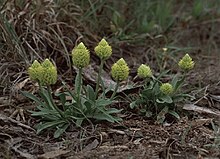| Senega nana | |
|---|---|

| |
| Scientific classification | |
| Kingdom: | Plantae |
| Clade: | Tracheophytes |
| Clade: | Angiosperms |
| Clade: | Eudicots |
| Clade: | Rosids |
| Order: | Fabales |
| Family: | Polygalaceae |
| Genus: | Senega |
| Species: | S. nana |
| Binomial name | |
| Senega nana (Michx.) J.F.B.Pastore & J.R.Abbott | |
| Synonyms | |
| List | |
Senega nana, commonly known as candyroot or low bachelors' buttons, is a small species of herbaceous plant native to the south-eastern United States. The root has a sweet liquorice flavor when it is chewed, but it is usually hidden underground until the plant flowers. The seeds of candyroot are dispersed by ants.
Taxonomy
French botanist André Michaux described candyroot as a variety of Polygala lutea in 1803. Swiss botanist Augustin Pyramus de Candolle reclassified it as a species in 1824. The species name is the Latin word nanus "dwarf".
Description
Candyroot grows as a clumping herbaceous plant 10–15 cm (4–6 in) tall, more commonly 5–10 cm (2–4 in) tall. Growing from the base of the plant are the spathulate (spoon-shaped) leaves, which are 1.5–5 cm (1⁄2–2 in) long and 0.4–2 cm (1⁄4–3⁄4 in) cm wide. The yellow flowerheads are composed of tiny flowers arranged in racemes, and are 2–4 cm (3⁄4–1+1⁄2 in) high by 1.5 cm (1⁄2 in) wide. They appear from April to June, from March to October in Alabama, and year-round in the Everglades. The seeds are smaller than 1 mm in size. The edible root tastes of licorice.
Senega nana resembles Senega lutea, which is a taller plant. It also resembles the rare species P. smallii of Miami-Dade County, which has seeds longer than 1 mm.
Distribution and habitat
Senega nana is found across the south-eastern United States from far eastern Texas through Louisiana and Arkansas to Florida and north as far as the Carolinas. Arkansas, where it is found in Ashley, Bradley and Calhoun Counties, marks the northwestern limits of its range. It grows in moist soil in meadows or coniferous woodlands.
References
- Michaux, Andreas (1803). Flora boreali-americana :sistens caracteres plantarum quas in America septentrionali collegit et detexit Andreas Michaux. Vol. 2. Paris, France: Levrault brothers. p. 54.
- De Candolle, Augustin Pyramus (1824). Prodromus Systematis Naturalis Regni Vegetabilis. Vol. 1. Paris, France: Treuttel et Würtz. p. 328.
- ^ Lady Bird Johnson Wildflower Center (2015). "Polygala nana". NPIN: Native Plant Database. Austin, TX: University of Texas at Austin. Retrieved 18 July 2015.
- ^ Godfrey, Robert K.; Wooten, Jean W. (2011). Aquatic and Wetland Plants of Southeastern United States: Dicotyledons. University of Georgia Press. p. 275. ISBN 9780820342436.
- Blanche E. Dean; Amy Mason; Joab L. Thomas (1983). Wildflowers of Alabama and Adjoining States. University of Alabama Press. p. 94. ISBN 9780817301477.
- ^ Hammer, Roger L. (2015). Everglades Wildflowers: A Field Guide to Wildflowers of the Historic Everglades, including Big Cypress, Corkscrew, and Fakahatchee Swamps. Rowman & Littlefield. p. 143. ISBN 9781493014590.
- Natural Resources Conservation Service (2015). "Polygala nana (Michx.) DC. Show All candyroot". Plants Database. USDA. Retrieved 18 July 2015.
- Hunter, Carl G. (2000). Wildflowers of Arkansas. University of Arkansas Press. p. 126. ISBN 9780912456164.
- Biota of North America Program 2014 county distribution map
| Taxon identifiers | |
|---|---|
| Polygala nana |
|
| Polygala lutea var. nana | |